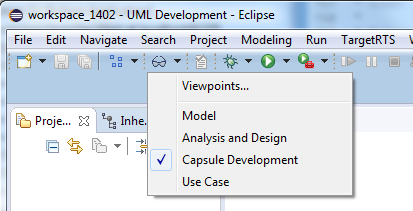

Despite the fact that Model RealTime was originally designed as a strict follower of the UML2 standard, the vast majority of our current users exclusively build applications in C/C++. Those of you who are used to think and design more in the C++ domain rather than in UML, will appreciate our current efforts of streamlining the user interface for C++ developers. This is still work in progress, but you can take a look on what already have been done.
As an Model RealTime C++ user, you should activate the "Capsule Development" view point. If you are running Model RealTime with the default settings, this perspective would be active from the beginning.

The general goal of simplification is to show only those elements, properties, names, labels and signatures which users find relevant. In addition to better tool performance, this helps users to easily find and use the information they need. The Project Explorer and the Properties view are the main parts of the user interface that are affected by the C++ adoption. There are too many changes to list them all, but here are some of the most significant ones:
RT stereotypes, like «capsule», are hidden (in most cases it’s enough to see the icons).
"Uninteresting" elements are hidden such as Event Containers, separate nodes for Default Values and upper/lower bounds of multiplicity.
Menu items that are not supported by the code generator, are filtered out from the Add UML context menu: Regions, Entry/Exit Points, Do/Entry/Exit Activities, Information Items, Primitive Types and Element Import for packages, Attributes and Parts for Protocols, Effects and Triggers for Call Events and more.
Properties are renamed and filtered: "Visibility" property is removed for Packages and Protocols, "Leaf" property is removed for all elements, "Polymorphic" property is renamed to "Virtual", "Abstract" to "Pure Virtual" and so on.
Property pages are reorganized (non-applicable sections are hidden, related properties are placed together in one row, layout is adjusted to allocate more space for type definitions).
The Literals and Parameters property pages are redesigned to be in line with the style of the Attribute property page.
We still have a couple of improvements in the backlog such as C++ syntax support for creating elements and C++-to-model synchronization. But we are eager to receive your feedback and proposals for how Model RealTime can become even more C++-friendly. Send us your proposals to model-realtime@hcl-software.com and your idea will be taken into account.